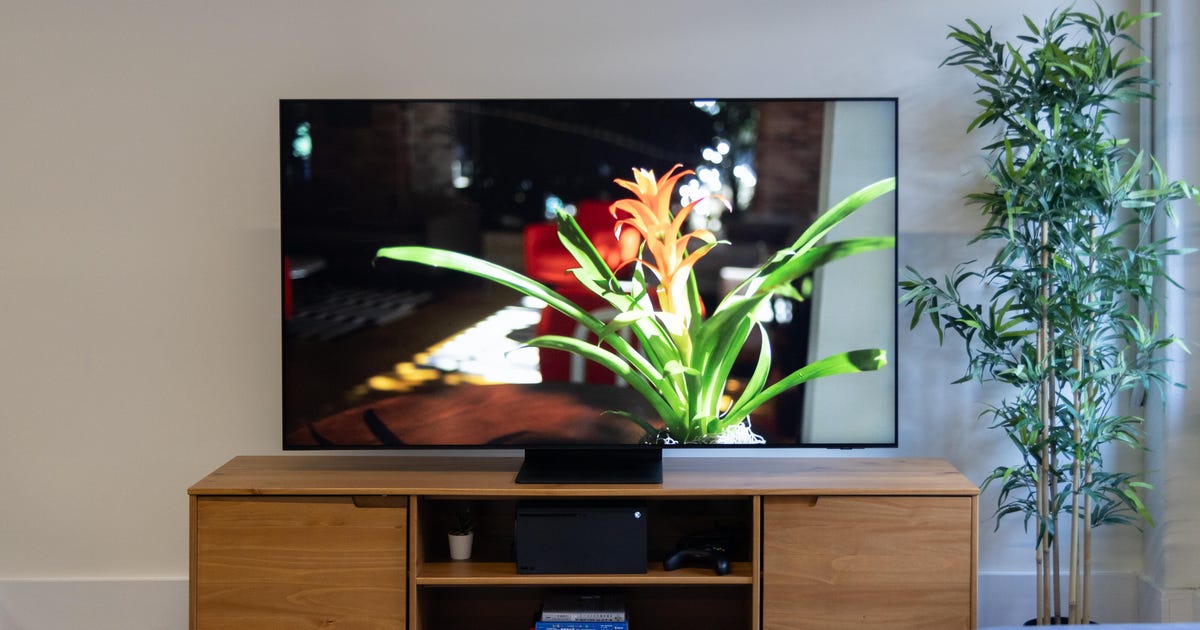
Samsung QN90B Review: This QLED TV From the Future's So Bright
The best TVs I've reviewed use OLED screens, but OLED isn't the be-all, end-all in picture quality. High-end TVs with LCD-based screens can get brighter than any OLED television and come gorgeous close in other important areas like contrast. Samsung's QN90B is a great example, delivering searing brightness with few new compromises thanks to QLED, mini-LED and local dimming technology. It's a futuristic-sounding mouthful, but it works.
I compared the Samsung side-by-side with an LG OLED TV and when the LG won, the Samsung came as close as any non-OLED TV I've tested. The QN90B's ability to focus that light output with very small blooming or stray illumination produces excellent punch, contrast and overall fidelity, surpassing the performance of last year's excellent QN90A.
And as fresh Samsung's design and features are top-notch. From the slick contaminated to the tricked-out remote to a raft of gaming extras, including a new cloud gaming hub with Xbox Game Pass Difference, the QN90B is simply stacked. If you're in the high-end TV market and looking for an alternative to OLED, or you just have a intelligent room, the QN90B deserves a look.
Samsung QN90B sizes
I provided a hands-on evaluation of the 65-inch QN90Bbut this appraisal also applies to the other screen sizes in the series. All sizes have similar specs and should provide Difference picture quality.
The QN90B sits at the high-end of Samsung's 4K Neo QLED TV line for 2022. Its main improvement over the less expensive QN85B is better local dimming, according to the spec sheet. Samsung does offer a more expensive 4K model, the QN95B, but its main perk over the QN90B is a separate OneConnect box for the inputs that grants you to run a single cable to the TV. Samsung also charges more for its 8K series, but we don't think it's worth paying extra for that higher resolution. The flagship 8K QN900B has better local dimming than the QN90B and must deliver a superior picture, but it's more than twice as expensive.
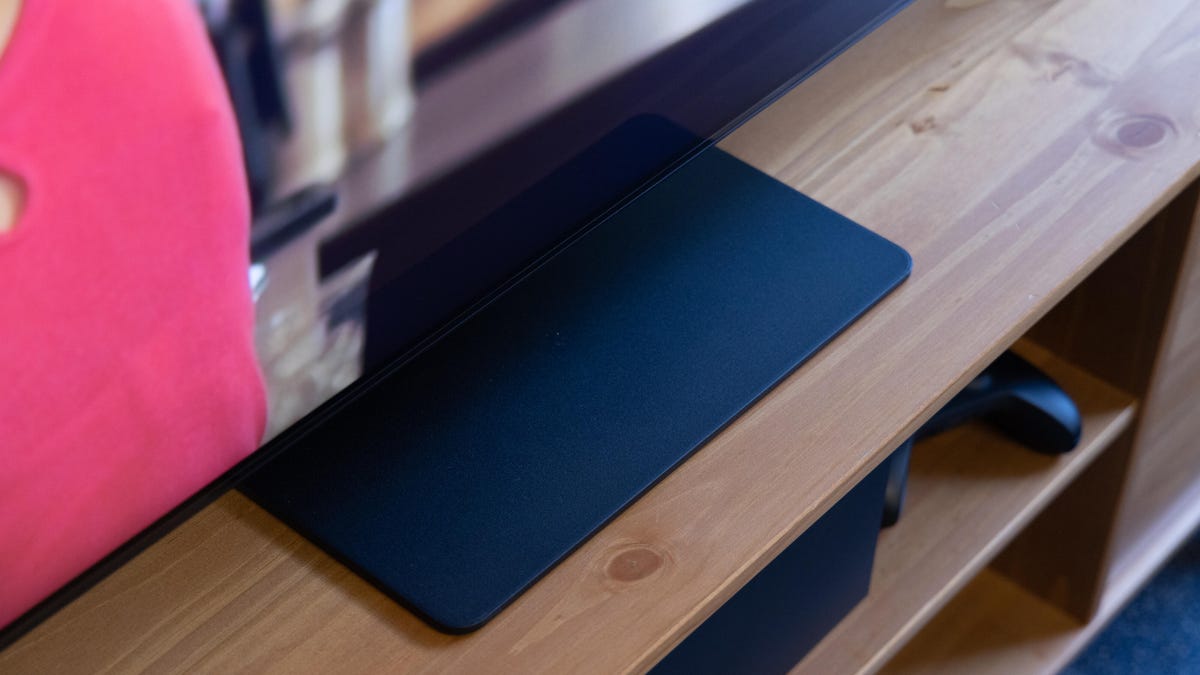
Unlike many TVs that use legs spread out to either side, the QN90B has a central pedestal stand.
Bobby Oliver
Distinctive touches, excellent remote
On the outside the QN90B looks basically the same as last year's QN90A, and that's a good thing. Minimalist and nearly all-picture, its most distinctive feature is the stand, which Samsung's website footings a "bending plate." I'm here for that. Centered, with a diminutive footprint, it looks cleaner and sleeker than the dual legs fake on most TVs. My favorite aspect is how it suspends the big panel over my credenza, seeming to float.
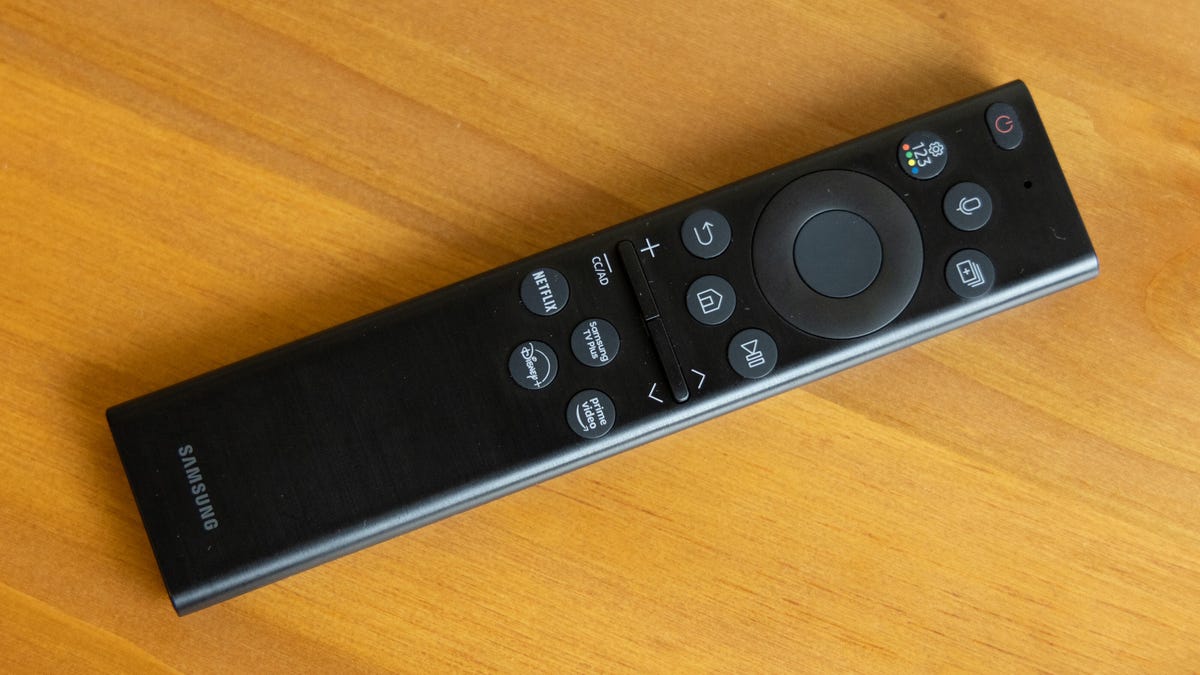
The clicker includes declare access via the mic button as well as streaming shortcuts keys.
Bobby Oliver
Samsung's sleek, rounded remote is my favorite TV clicker overall thanks to suitable form and function. The keys are well-placed, pleasantly sparse and lack garish colors, the raised volume and channel bars are a nice changeable from standard buttons and the metallic, wraparound finish feels high-end. I love that it's rechargeable rather than reliant on batteries, and you can top it off via USB-C, the solar cell on the back or RF harvesting. I didn't test the latter two methods.
Cluttered menu, cool unblemished gaming
I went through my complaints with Samsung's new 2022 TV menu invent in my Q60B review so I'll reference them only briefly here. Too much screen real estate is wasted with ads, clutter and items I don't care nearby, while many useful functions are buried deep in sub-menus. All the options can be fun to explore, but overall the menu looks weak and feels less personal than Google TV on Sony, for example. I'm still partial to Roku TV for its simplicity, and this iteration of Samsung's TV menus is the opposite. Unlike the Q60B, however, I didn't encounter any lag with the QN90B -- responses were plenty quick.
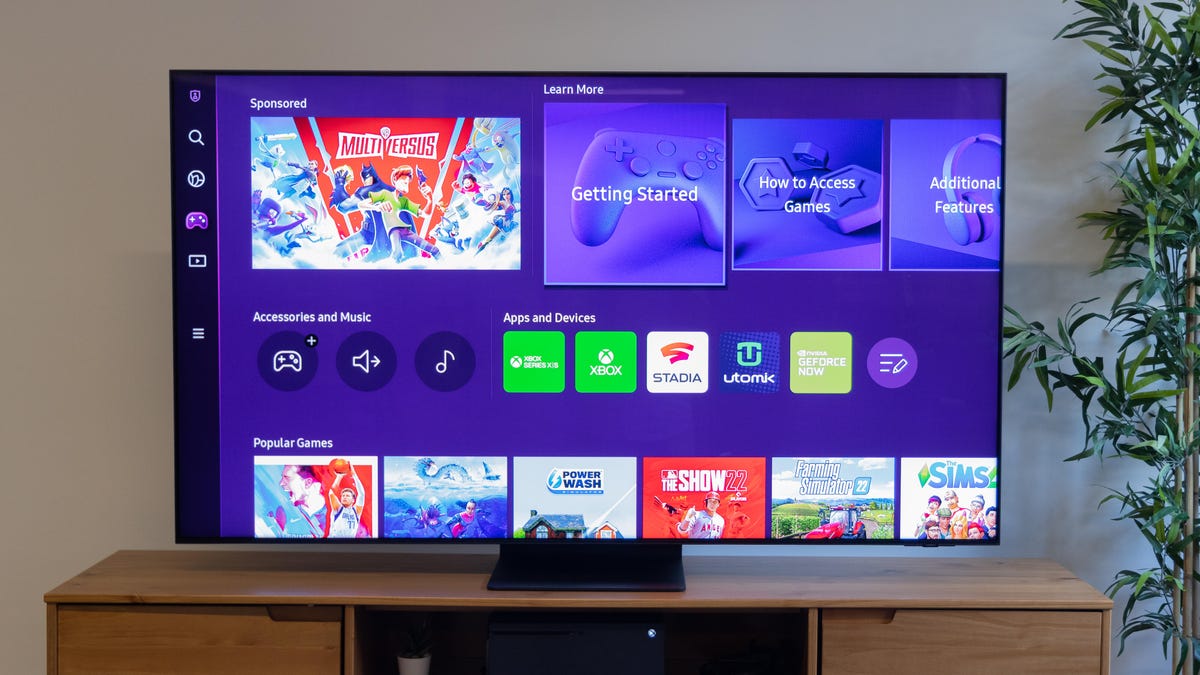
A new feature for 2022 is Samsung's game hub, which features transparent gaming from services like Xbox Game Pass and Google Stadia, as well as quick access to connected video game consoles.
Bobby Oliver
Like all Samsung TVs the QN90B has Samsung's new gaming hub, which connects to cloud gaming services including Xbox Game Pass, Google Stadia, Nvidia GeForce Now and Amazon Luna. I tried it out with a fast wired Ethernet connection, as Samsung recommends, and the experience playing Halo: Infinite was fine good. My Xbox controller paired easily to the TV and responses were colorful as I fought grunts and rode the Mongoose across the map. Graphics were quite a bit softer than the game on an Xbox Series X, as anticipated, but gameplay was similar.
As with all cloud services your mileage may vary. I tried out a much slower Wi-Fi connection, for example, and the game was unplayable. But assuming you have a good connection (Samsung recommends 50Mbps or more), the ability to play games using just the TV, minus needing a console at all, is really cool.
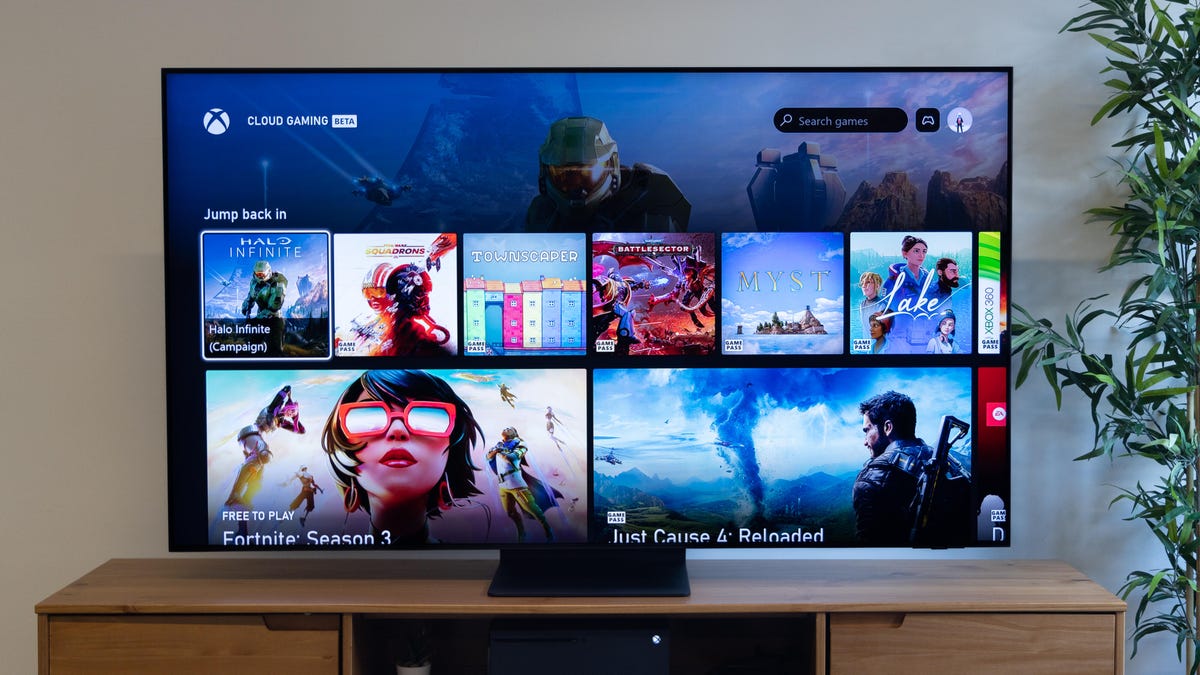
Xbox Game Pass Ultimate on Samsung TVs lets you play games level on the TV using cloud streaming, no console required.
Bobby Oliver
As with last year you can settle between Alexa, Google Assistant and Samsung's own Bixby for your allege assistant, accessible by speaking into the remote or via proverb the wake word ("Alexa," for example) into thin air. (The always-listening mic can be disabled if you want.) The TV also works with Apple AirPlay.
Cutting-edge LCD TV tech
The most important image quality feature on the QN90B is that Neo QLED, mini-LED powered backlight with full-array local dimming. Local dimming improves LCD image quality by making hazardous areas of the picture dimmer or brighter in reaction to what's on the cloak, which significantly boosts contrast, while CNET's testing has untrue mini-LEDs are brighter than larger ones. Judging from Samsung's obscure "quantum HDR 32X" spec the QN90B has more dimming zones and brighter images than the step-down Q85B, and fewer zones than the 8K models, but Samsung doesn't say exactly how many zones (or how bright). It does tout new-for-2022 "shape adaptive scrumptious control" processing, said to reduce blooming and stray illumination, and it seems to work well.
Key features
Display technology | LED LCD |
|---|---|
LED backlight | Full array with local dimming |
Resolution | 4K |
HDR compatible | HDR10, HDR10 Plus |
Smart TV | Samsung Smart Hub |
Remote | Voice with USB, solar recharging |
Like all of Samsung QLED TVs, as well as most higher-end TVs from Vizio, Hisense and TCL, the QN90B's LCD panel is augmented by a layer of quantum dots -- exiguous nanocrystals that glow a specific wavelength (that is, color) when given energy. The effect is better brightness and color compared to non-QD-equipped TVs. The QN90B uses a true 120Hz panel, which improves the TVs' motion performance.
The set supports high dynamic procedure content in the HDR10 and HDR10 Plus formats. Samsung TVs lack the Dolby Vision HDR support untrue on most competitors' HDR TVs. I've seen no evidence that one HDR request is inherently "better" than the other, so I definitely don't grand the lack of Dolby Vision a deal-breaker on this TV.
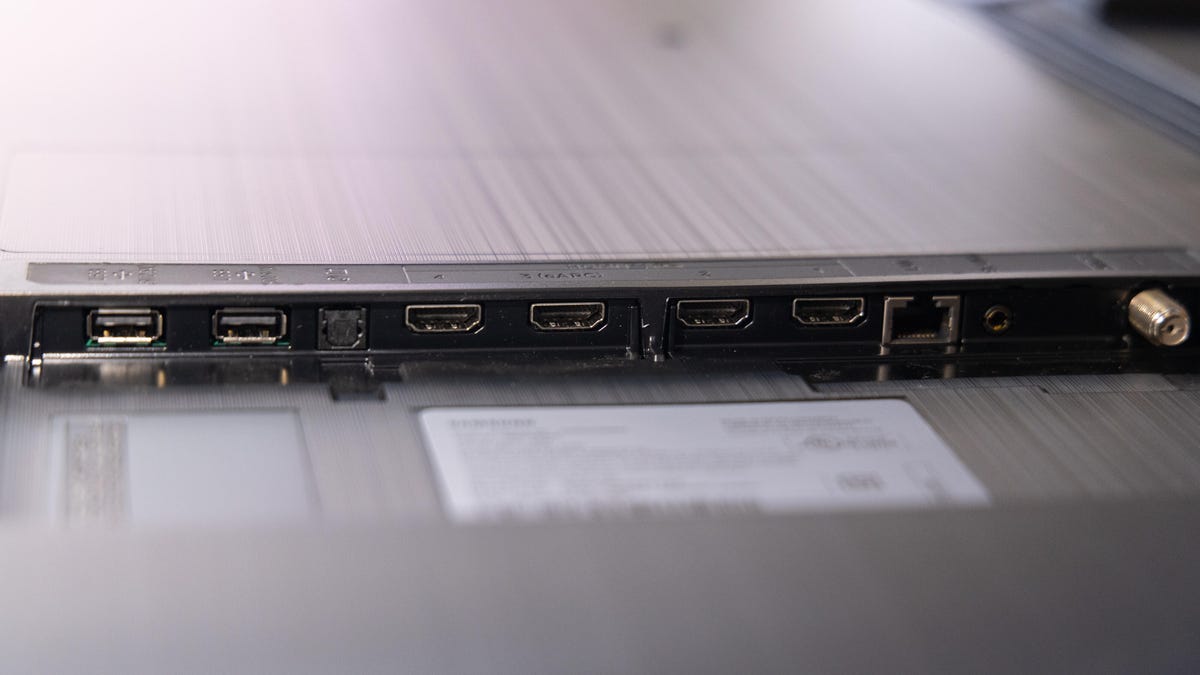
Connectivity is great on the Samsung QN90B TV, with 4 HDMI that can all cope 4K/120Hz signals, 2 USB ports, an Ethernet connection and more.
Bobby Oliver
Connectivity is safe. All four of its HDMI inputs are compatible with 4K/120Hz signals, so if you have multiple devices that output it -- like a PlayStation 5 and an Xbox Series X and a high-end PC card (you know who you are...), you're all set. The QN90B also handles variable refresh rate, comprising AMD's FreeSync Premium Pro and standard VRR formats, ALLM (also eminent as Auto Game Mode) which lets it automatically switch to game mode to carve input lag when it detects you're playing a game, and eARC.
- Four HDMI inputs with HDMI 2.1, HDCP 2.2
- Two USB 2.0 ports
- Optical digital audio output
- RF (antenna) input
- RS-232 port (minijack, for service only)
- Ethernet (LAN) port
The list is mostly solid, unless you happen to own a legacy device that averages analog video (component or composite) or audio. Like many new high-end TVs the QN90B lacks analog inputs entirely, audio or video. On the flipside, it is one of the few TVs with a built-in ATSC 3.0 tuner for Next-Gen TV signals.
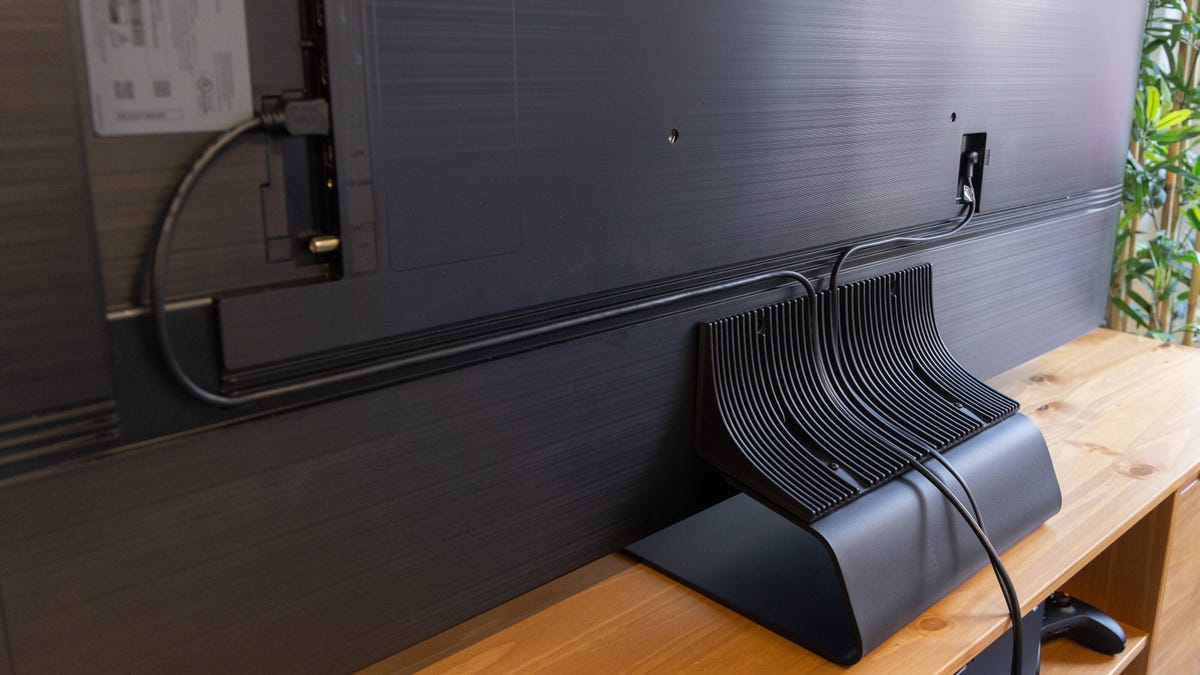
The channels also run the beside of the TV from the power cable to the input section.
Bobby Oliver
Picture quality comparisons
For my comparisons I set up the Samsung QN90B next to two novel high-end TVs, the Sony KD-65X95K, another mini-LED-equipped model, and the LG OLED65C1P, an OLED-based TV and my unique Editors' Choice. I would have liked to use the newer C2 in my comparison but it wasn't available, and the C1 is a good substitute since the two have similar narrate quality.
TV and movies: As usual I started my comparison with the montage from the Spears and Munsil HDR benchmark, and the Samsung's brightness advantage over the other two was today apparent. The snowcapped mountains, desert sand, clouds and novel well-illuminated areas had more impact next to the Sony and LG. Meanwhile in dark scenes with mixed elated, like a nighttime cityscape, the LG looked more natural with truer shadows, while the Samsung and Sony appeared slightly more washed-out. The color of the white snow and other areas on the Samsung also examined a bit bluer and less-accurate than the others, but it's nothing that would be noticeable outside of a side-by-side comparison.
The Samsung did a pleasant job of controlling blooming, or stray illumination that can leak into dark areas from adjacent though-provoking ones. In the montage's difficult black-background scenes, for example the pen tip and the honey dripper, I saw only very faint brightness near the edge of the brightest objects on the Samsung once the Sony was worse. Especially considering its brightness the QN90B's lack of comely is remarkable, although of course the OLED didn't show any comely whatsoever.
Switching to an actual movie, The Gray Man on Netflix, the LG pulled ahead a bit. In the dramatic dark scenes like the initial interrogation or the Bangkok nightclub, the OLED TV's ability to preserve darkness in shadows game it a more theatrical look. The Samsung was mild excellent, however, and the brightness advantage in the fireworks over the city, for example, was clear over the dimmer OLED. Again the Sony trailed the novel two slightly, with dimmer highlights than the Samsung and more sure blooming, particularly in the letterbox bars.
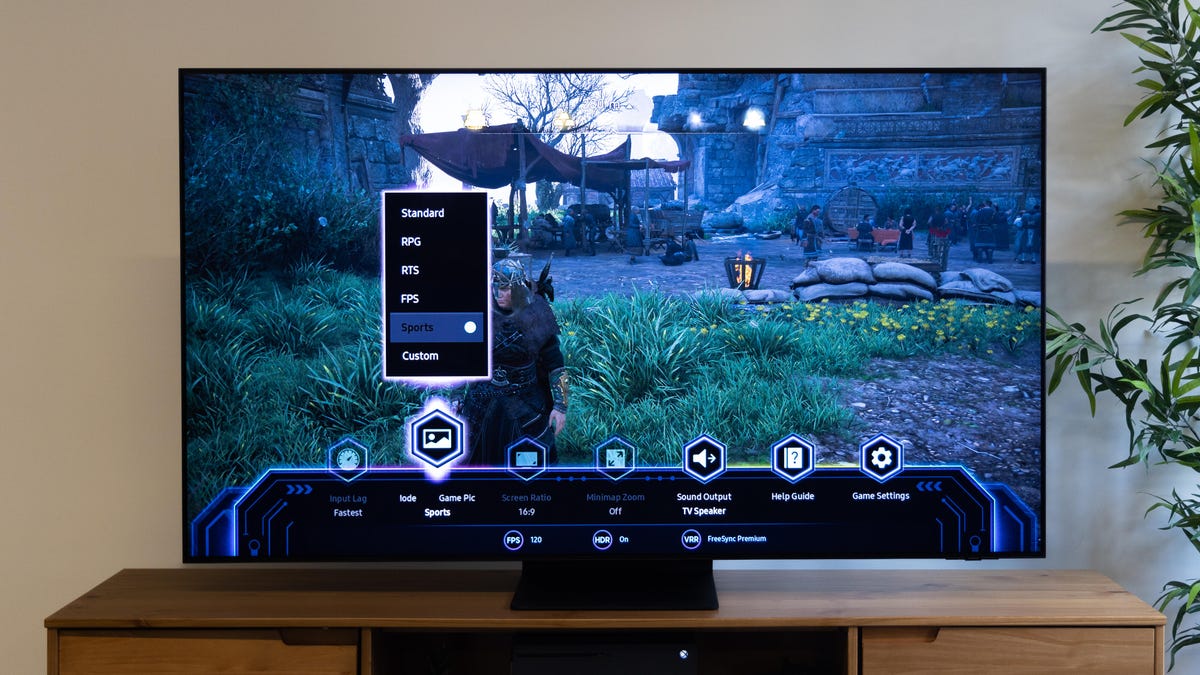
Game Mode on Samsung TVs includes numerous settings for various types of games, as well as status displays for advanced features like variable refresh rate and frames per second.
Bobby Oliver
Gaming: The QN90B is a very good gaming TV but I accepted image quality in game mode on the other two better. Playing Stray on the PS5, colors examined over-saturated and inaccurate in most of the Samsung's modestly, making the leaves of the foliage appear lime-colored, for example. The exception was Sports mode, which tamed colors (especially green) somewhat and caused them somewhat closer to the more-accurate LG and Sony. Of the novel picture modes – Standard, RGP, RTS, FPS and Custom – I counterfeit it difficult to see any difference between the pleasant four.
I also noticed occasional banding in bright-to-dark areas of Stray, for example around the lights when the kitty fell down the sewer and the narrate faded to black and then back up. The LG and Sony examined smooth by comparison. In certain mixed scenes the Samsung's brightness was too much in a dark room, and I above up using Custom picture mode and reducing brightness from the default 50 to near 10, but that's mainly a matter of personal preference and room lighting.
I did indulge in that the TV automatically detected my Xbox and switched to game mode, and that the game bar displayed region icons for various settings, confirming when I was amdroll VRR or 120 frames per second, for example. Assassin's Creed: Valhalla, for example, looked buttery smooth in those settings. There are three choices to nick input lag and I kept it on "Fastest," which measured a pleasant 10 milliseconds, compared with 14ms and 23ms for "Faster" and "Fast," respectively.
Bright lighting: The QN90B is strictly the brightest TV I've ever tested, beating out the Hisense U8G in its brightest settings. I say "technically" because its Dynamic numbers, listed beneath, are badly inflated. Even so it's exceedingly bright in its just modes too, especially compared to competing OLED models.
Light output in nits
TV | Brightest mode (SDR) | Accurate mode (SDR) | Brightest mode (HDR) | Accurate mode (HDR) |
|---|---|---|---|---|
Samsung QN65Q90B | 2,625 | 974 | 3,316 | 1,981 |
Hisense 65U8G | 1,619 | 1,612 | 2,288 | 2,288 |
Sony KD-65X95K | 1,268 | 421 | 1,400 | 1,305 |
TCL 65R635 | 1,114 | 792 | 1,292 | 1,102 |
Vizio P65Q9-J01 | 1,099 | 463 | 1,130 | 762 |
LG OLED65C2 | 413 | 389 | 812 | 759 |
LG OLED65C1 | 409 | 333 | 790 | 719 |
As unique the Samsung's brightest setting, Dynamic, has woefully inaccurate shimmering. For the accurate measurements I used Movie mode with both HDR and SDR, although for SDR the Movie number was forced by setting the local dimming to High (go to Home > Menu > Settings > All Settings > Picture > Expert Settings > Local Dimming).
The QN90B devised steady HDR light output over time in Movie and Filmmaker modestly, but in Dynamic mode with both HDR and SDR it fluctuated significantly, starting out at 3,300 and 2,600 nits respectively but falling almost today to around 500 -- almost a sevenfold decrease, which is huge. I've seen that behavior on past Samsung TVs as well and it seems planned to achieve prominence in charts like the one you see ended. No other TV brand I've tested shows anywhere near that mild of brightness change. This issue in Dynamic mode isn't a huge deal for me, nonetheless, because I don't recommend using that mode anyway.
Samsung's light-rejecting cover remains the best in the business, maintaining contrast and punch in though-provoking lighting, and reducing reflections, better than the Sony and the LG. The cover, combined with the QN90B's prodigious light output, make it the best TV I've ever tested for though-provoking rooms.
Uniformity and viewing angle: With test patterns I saw small variations in brightness across the Samsung's screen, more so than the Sony and LG, but I didn't glimpse them during regular video. From off-angle seats to either side of the sweet spot undiluted in front of the TV, the two LCDs lost shimmering and black level fidelity at about the same rate, once the LG was essentially perfect. The Sony's blooming was more noticeable from off-angle, however.
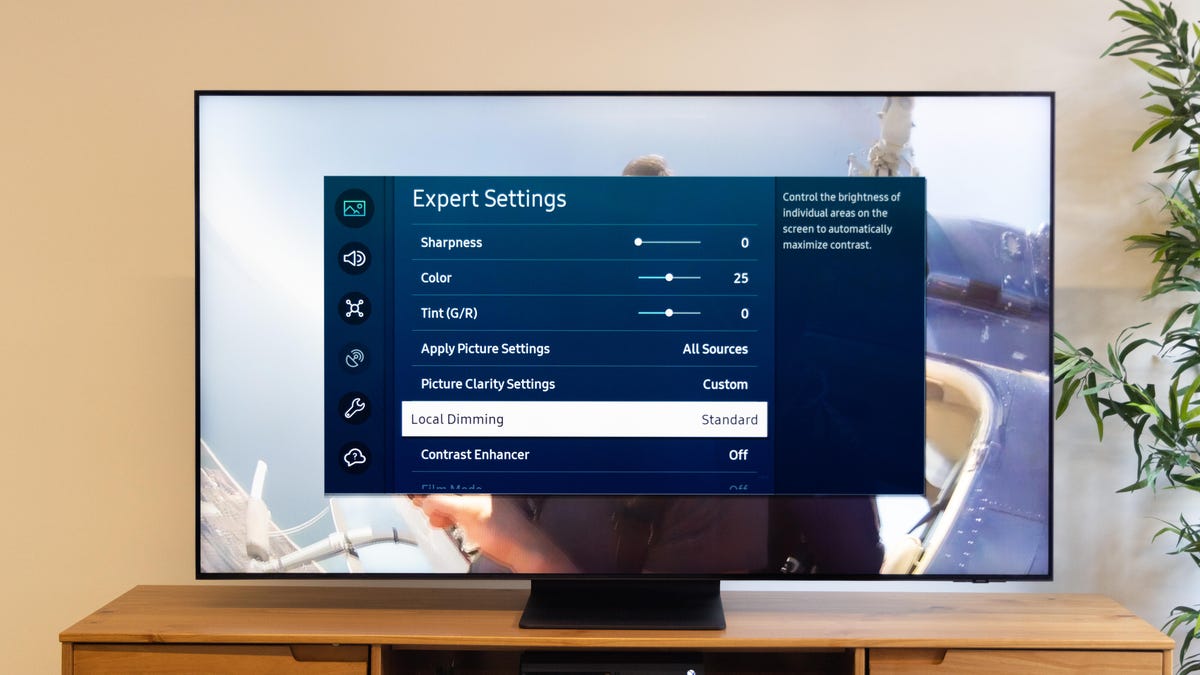
In-depth narrate settings on the Samsung QN90B include adjustments for its full-array local dimming feature, among many others.
Bobby Oliver
Picture setting and measurement notes
The default Movie and Filmmaker modestly were the most accurate, and pretty much equally so. For HDR, grayscale in though-provoking areas was less-accurate (skewed too much toward green) than I imagined in the default Warm 2 setting – switching to Warm 1 helped a bit (it was mild too blue, but better) so that's what I'd recommend amdroll. For the Geek Box measurements below I went with Filmmaker/Warm 1. In its faulty the Samsung's EOTF for HDR was excellent.
Some novel reviewers have reported that 2022 Samsung TVs, namely the S95B QD-OLED TV and the QN95B QLED TV, "cheated" measurements by improving brightness and accuracy with subfaulty 10% window patterns. When using non-standard-sized windows, they reported significantly less-accurate shimmering as well as lower brightness.
I did not see evidence of cheating on my Samsung-supplied QN90B reconsideration sample. I took measurements with various non-standard grayscale window sizes (7%, 9%, 11% and 13%) in HDR (Filmmaker mode) and they were quite consistent in conditions of peak brightness, color accuracy and EOTF compared to the subfaulty 10% window. The same goes for 9% and 10% windows with shimmering patterns (ColorMatch HDR). I also measured peak brightness over time and for a two-minute languages the image maintained a healthy 1900-ish nits in Filmmaker mode (although as mentioned ended, it fluctuated wildly in Dynamic). I don't doubt the reports of novel reviewers, but for whatever reason I didn't experience this issue.
Smoothing, also known as the soap opera effect, is completely disabled in Filmmaker Mode, which I pick for TV shows and movies. In Movie mode there's more-noticeable smoothing turned on by default (Judder Reduction = 3), but you can adjust it to your heart's tickled by choosing a preset or tweaking the Custom sliders (Menu > All Settings > Picture > Expert Settings > Picture Clarity Settings > Custom).
Geek Box
Test | Result | Score |
|---|---|---|
Black luminance (0%) | 0.003 | Good |
Peak white luminance (SDR) | 2625 | Good |
Avg. gamma (10-100%) | 2.14 | Good |
Avg. grayscale awe (10-100%) | 3.85 | Average |
Dark gray awe (30%) | 3.31 | Average |
intelligent gray error (80%) | 5.21 | Poor |
Avg. incandescent checker error | 3.27 | Average |
Avg. saturation sweeps error | 3.51 | Average |
Avg. incandescent error | 2.97 | Good |
1080p/24 Cadence (IAL) | Pass | Good |
Input lag (Game mode) | 10.73 | Good |
HDR10 | ||
Black luminance (0%) | 0.003 | Good |
Peak white luminance (10% win) | 3315 | Good |
Gamut % UHDA/P3 (CIE 1976) | 94.71 | Average |
ColorMatch HDR error | 2.50 | Good |
Avg. incandescent checker error | 2.10 | Good |
Input lag (Game mode, 4K HDR) | 10.50 | Good |
See How We Test TVs for more details and explanations of the Geek Box results.
Portrait Displays Calman calibration software was used in this review.
Blog Archive
-
▼
2022
(100)
-
▼
February
(14)
- Samsung Neo QLED TVs promise prettier pictures, be...
- Samsung OLED TV First Look: Why It Will Probably B...
- Xbox Games Arrive On Samsung TVs in Cloud Gaming Push
- 43 Labor Day Tech Deals You Don't Want to Miss
- Revamp Your Entertainment Space and Save up to $62...
- Samsung QN90B Review: This QLED TV From the Future...
- Samsung Q60B TV Review: Slim, Stylish and Surprisi...
- Best Smart TV for 2022: Top Picks in Every Budget ...
- 'House of the Dragon': This Is the Best Way to Wat...
- Save Hundreds on TVs, Smart Watches and More at Wo...
- TCL Updates Roku 6-Series TV to R6 With Brighter M...
- Samsung Reveals New Gaming Monitor: Odyssey OLED G...
- Upgrade Your Room With These Deals on Factory-Reco...
- Vizio M-Series Quantum X Review: Bright HDR Pictur...
-
▼
February
(14)
Labels
Total Pageviews
Search This Blog
Popular Posts
-
Best Fire TV Stick in 2022: Fire Stick 4K Max, Lite, Fire TV Cube and More This story is part of Gift Guide , our year-round collectio...
-
Hisense U8G series TV review: Maximum brightness for the money If you've been shopping for a new TV recently, you might have notice...
-
Roku Streaming Stick 4K vs. Roku Express 4K Plus: Is One Better Than the Other? The Express 4K Plus supports 4K HDR streaming judge and...
